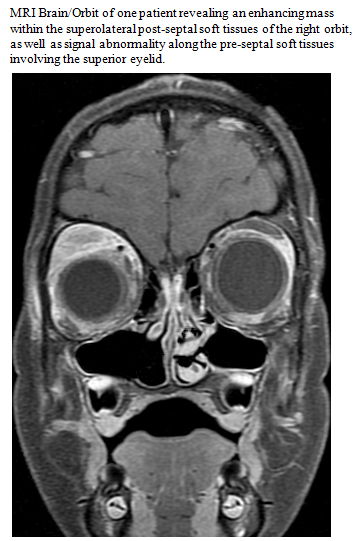Session Information
Session Type: Abstract Submissions (ACR)
Background/Purpose: Ocular involvement, particularly orbital pseudotumor, has been reported as the initial manifestation of ANCA-associated vasculitis (AAV) in the adult population, predominantly in granulomatosis with polyangiitis (GPA) with less frequency in Churg-Strauss syndrome (CSS) and microscopic polyangiitis (MPA). There are several cases in the literature of pediatric patients with GPA presenting with orbital pseudotumor, however to our knowledge there are no published cases of this type of presentation in childhood CSS or MPA.
Methods: During the period between 2009 and 2014 three cases of orbital pseudotumor were diagnosed in our Pediatric Rheumatology Division. A thorough chart review was conducted on these patients regarding clinical presentation, laboratory data, imaging studies and pathology. A literature review was then completed in PubMed looking for individual reports of pediatric ANCA-associated vasculitis, as well as previously reported cases of orbital pseudotumor in both adults and children.
Results: Four reports in PubMed were published regarding orbital pseudotumor and ANCA-associated vasculitis in pediatrics. Within these studies there were 15 cases of pediatric AAV presenting as orbital pseudotumor, all of which were limited to GPA. There was no published evidence of this initial presentation in either CSS or MPA in the pediatric population. The characteristics of our patients are listed below:
Conclusion: When pediatric patients present with orbital pseudotumor the differential should be widened regarding types of ANCA-associated vasculitides to include CSS and MPA. Recognizing these possibilities would allow for early screening and monitoring for potential multi-organ involvement.
Disclosure:
A. Schlefman,
None;
M. Leffler,
None;
A. C. Brescia,
None;
C. D. Rose,
None.
« Back to 2014 ACR/ARHP Annual Meeting
ACR Meeting Abstracts - https://acrabstracts.org/abstract/orbital-pseudotumor-as-the-presenting-symptom-of-pediatric-anca-associated-vasculitis/


